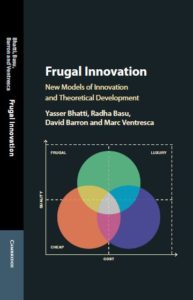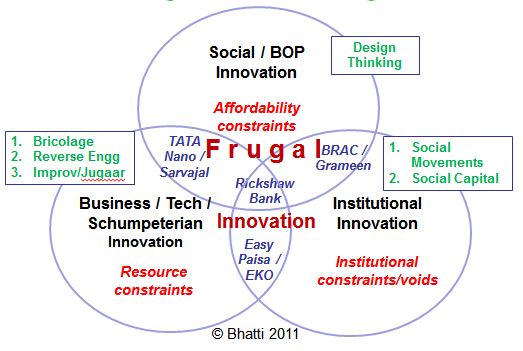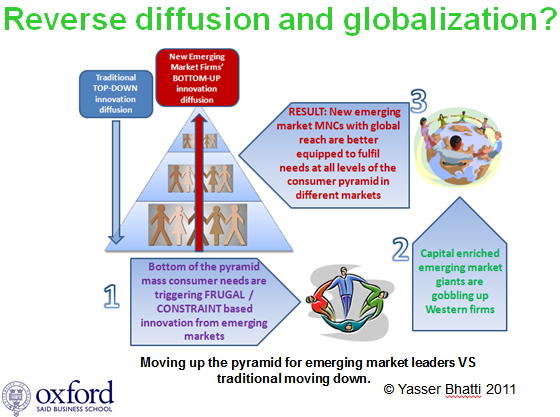New Book — Frugal Innovation: Models, Means, Methods. Cambridge University Press

Bhatti, Y., Basu, R., Barron, D., & Ventresca, M. 2018. Frugal Innovation: Models, Means, Methods. Cambridge University Press.
Cambridge website / Amazon website
In light of growing discourse on ‘frugal innovation’, this book offers novel approaches to innovation based on extensive empirical research. The study complements a decade of scholarly attention on frugal innovation by taking a research-based approach to innovation in resource-scarce and complex institutional contexts. The findings suggest that concepts such as frugal, reverse, jugaad, social, grassroots and inclusive innovation in fact represent heterogeneous assemblies of innovation for social, environmental and economic value. The conceptual framework invites attention to more plural sources and elements in the study of models of innovation to inspire further research in the fields of strategy, innovation, entrepreneurship, economic sociology and development studies. The design framework offers models, metrics and competencies for practitioners and policymakers to identify, evaluate and design frugal innovations. The comprehensive view of frugal innovation demonstrates how firms can implement globally competitive strategies by pursuing innovation for humanity to improve lives for everyone, everywhere.
Foreword by Anita McGahan, Rotman Chair in Management and Professor of Strategic Management at Rotman School of Management, University of Toronto.
Order from Cambridge University Press or Amazon
Part I. Models of Frugal Innovation
Introduction
1. Outline of the Context, Literature and Methodology;
2. Conceptualising Innovation – Model 1
3. Conceptualising Innovation under Constraints – Model 2
Part II. Towards a Theory of Frugal Innovation
4. Integrative Results and Theory Development
5. Test of Models Using Secondary Cases
6. Emerging Concepts in Innovation
7. Implications for Research, Practice and Policy
Conclusion
Part III. Tools for Practice and Research
A. Toolkit to Identify and Categorise Frugal Innovations
B. Core Competencies from the Frugal Innovation Lab
C. Detailed Research Methodology and Design
References
Bilbiography of Frugal Innovation
Reviews
“Policymakers around the world and especially in emerging markets can leverage frugal innovations to better promote human welfare. The models and tools in this book should support leaders in their efforts to foster equitable growth and sustainable development.”
Shaukat Aziz
Chairman of the Oxford Emerging Markets Symposium Steering Committee and former Prime Minister of Pakistan
“This book should give tremendous impetus for serious and rigorous academic research on innovation under severe constraints.”
Vijay Govindarajan
Coxe Distinguished Professor at Tuck, Dartmouth and author of the NYT Best Seller, Reverse Innovation
“This book complements previous books in helping to establish frugal innovation as a field that merits serious attention in the diverse worlds of academia, practice and policy. It extends prior work by developing models, frameworks and tools to help scholars, innovators and managers to deliver meaningful and much needed innovation for all of humanity.”
Jaideep Prabhu
Professor of Marketing at Judge Business School, Cambridge and author of best sellers Jugaad Innovation and Frugal Innovation
“To solve the wicked problems confronting humanity and the planet, we need frugal innovators—wise problem solvers who operate with a business mind, social heart, and ecological soul. Building on earlier works on frugal innovation, this scholarly book offers a rigorous theoretical framework to understand, teach, and practice the art and science of designing and delivering frugal solutions that integrate six key elements: affordability, accessibility, simplicity, sustainability, quality, and purpose.”
Navi Radjou
Fellow at Judge Business School, University of Cambridge and coauthor of Jugaad Innovation and Frugal Innovation
“Frugal innovation is a topic of considerable interest to companies, policy makers and researchers. It offers both innovation to connect the poorest and most disadvantaged citizens to the benefits of new products and services and opportunities for firms to identify new and potentially lucrative markets. This important book offers important new conceptual and practical insights into frugal innovation and should be seen as essential reading for anyone engaging with this topic.”
Alex Nicholls
Professor of Social Entrepreneurship, Said Business School and Fellow in Management, Harris Manchester College, University of Oxford.
“Targeted to scholars and providing a solid foundation for future research, Frugal Innovation also offers keen insights on how social entrepreneurs conceive of innovation in multiple dimensions. Practitioners will find experience-based frameworks that help them synthesize and communicate the integrative nature of innovations that benefit the underserved. Like social entrepreneurship, frugal innovation is a term with many meanings. Integrative, synthetic, and clear, the authors examine multiple dimensions of innovation and distill frugal innovation as a hybrid approach tuned to environments with extreme resource constraints and resource voids. Both researchers and practitioners will benefit from learning how social entrepreneurs themselves perceive innovation.”
Thane Kreiner
Howard and Alida Charney University Professor and Executive Director, Miller Center for Social Entrepreneurship, SCU
“Frugal Innovation: New Models of Innovation and Theoretical Development will be a must have for academics, entrepreneurs, corporates and investors. It will advance how to get to inclusive solutions not merely based on cost-effectiveness and financial returns but combining them with purpose & impact. This book shows that Frugal Innovation is not just another innovation term but the empirical based models and theories that the authors have proposed will help enable creating & scaling solutions under resource constraints both by social entrepreneurs & traditional businesses.”
Venkata Gandikota
President and co-founder, The Nordic Frugal Innovation Society
“New models of innovation are desperately needed in global health systems which are being squeezed by increasing demand, declining budgets and rising complexity of disease. This book shows how frugal innovations can play a vital role in containing soaring healthcare costs while upholding quality standards, something which simply cannot be compromised in healthcare.”
Ara Darzi
Professor of Surgery at Imperial College London, member of the United Kingdom’s House of Lords and former Parliamentary Under-Secretary of State at the Department of Health.
“This book is needed! The marrying of social value and business value has gained steam in many circles with a focus on value – both human and economic. Frugal Innovation widens the path for intrepid innovators by grounding insightful conceptual frameworks upon an extensive base of empirical evidence.”
Kristian Olson
Director of the Consortium for Affordable Medical Technologies and Associate Professor, Harvard University Medical School
Challenges of Frugal Innovation and Role of Business Models
The following is a presentation to students of Radha Basu’s Engineering for the Developing World class at Santa Clara University’s Frugal Innovation Lab. The topic focused on showing how technology innovation alone is insufficient to overcome challenges in emerging markets and the role business models play in incorporating wider issues such as institutional and social innovation into the solution.
Challenges of Frugal Innovation and Role of Business Models by Yasser Bhatti is licensed under a Creative Commons Attribution 3.0 Unported License.
Based on a work at Said Business School, Oxford University and at Santa Clara University.
This license lets you distribute, remix, tweak, and build upon my work, even commercially, as long as you credit the original creation.
More PowerPoint presentations from Yasser Bhatti
Presentation
The following is an extraction of presentations I have made at international conferences and at Rethinking Business course for MBA students at Oxford University.
Frugal Innovation
Frugal Innovation — When Doing is Less New by Yasser Bhatti is licensed under a Creative Commons Attribution 3.0 Unported License.
Based on a work at Said Business School, Oxford University.
This license lets you distribute, remix, tweak, and build upon my work, even commercially, as long as you credit the original creation.
Research Summary
I study innovation in emerging markets, contexts marked by institutional voids, resource scarcity, and affordability constraints. My DPhil (PhD) programme’s broad research question is “How do institutionally complex and resource constrained environments affect the discourse in innovation and the practise thereof?” I look at the particular case of emerging markets and therein the emerging field of ‘frugal innovation’. I focus on the rise of talk, practices, and policy about ‘frugal innovation’, a trend questions prevalent notions of innovation — on what is innovation, where it stems from (sources), whom to target (users), how best to achieve (design process), and how it spreads (diffusion).
This research entails understanding how localization and globalization processes are shaping innovation in and for emerging and developing market economies. Innovators in emerging markets have to devise low cost strategies to either tap or circumvent institutional voids and resource limitations to innovate, develop and deliver products and services to low income users with little purchasing power, often at mass scale and arguably in a sustainable manner. Hence, two main challenges persist in emerging nations for innovation and entrepreneurship: First is the issue of dealing with complex institutional contexts (Mair, Marti, & Ventresca 2012), institutional voids (Khanna and Palepu 1997 and others) and resource constraints and second is the issue of addressing the needs of the bottom of the pyramid i.e. the largest and poorest socio-economic segment of the population (Prahalad 2005). Despite institutional voids or complexities, emerging market entrepreneurs and firms are producing innovations which are resolving their local needs, and at the same time scaling to neighboring developing nations and even beyond to developed markets (Khanna 2008).
Through field work, interviews, and archival data, I am revealing how actors in the private, public, and community sectors are creating the market for frugal innovations — affordable, high value and sustainable solutions for local problems of global concern, often in complex environments where resources are unavailable or hard to control. These range widely in terms of core technology, focus, and impact. To date, I have inductively addressed why this emerging organizational field is gaining traction, how the space is being negotiated, and how to operationalize the practice of frugal innovation towards future deductive empirical research.
- Theory of Frugal Innovation
Based on thus far 30 plus interviews and five focus groups as well as over 150 documentary evidence of innovation from real ventures, I find that frugal innovation spans the boundaries across social, technical and institutional innovations to carve out a unique space that is enabling the development of a new field within innovation studies. Further, I find that ‘frugal’ is neither cheap nor substandard, but rather uses market forces to provide for under-served populations in the most efficient and sometimes sustainable manner. Social entrepreneurs, MNCs, communities, and states alike are involved in this market building and field generation activity which leads to as many questions as answers.
Frugal Innovation Questions
Frugal innovation is a new phenomenon which is posed to rethink the innovation process!
Several questions remain unanswered for both academics and practitioners:
- What is frugal about frugal innovation?
- Is frugal innovation, innovation?
- How is it different or similar to standard innovation?
- What are the sources of frugal innovation? Who benefits?
- How does it relate to services and products?
- What is the design process for frugal innovation?
- Does cheap mean that it is low quality?
- Who is best at carrying out frugal innovation, local firms or MNCs?
The questions I am currently delving into as part of my PhD doctoral work are:
- What constitutes (frugal) innovation in or for emerging markets?
- What capabilities and core competencies are required to meet the needs of emerging market customers (i.e. frugally innovate)?
As my work progresses beyond the PhD, I aim to tackle supplementary questions such as:
- Are frugal innovation capabilities and core competencies unique to certain contexts and firms?
- How do emerging market firms differ from foreign firms in the capabilities to overcome contextual constraints in emerging markets?
- Do these capabilities and core competencies serve as a competitive advantage for firms?
Frugal-Reverse-Cost-BOP Innovation
CEO of GE Jeff Immelt calls the frugal innovation phenomenon reverse innovation. “If GE doesn’t master reverse (frugal) innovation, the emerging giants could destroy the company” (Immelt, Govindarajan, and Timble, 2009). Although there are several dimensions to frugal innovation, the overarching theme is simplification in process and outcome. There can be many connotations for “reverse” which are similar to frugal innovation in both process and outcome.
One, frugal or reverse innovation integrates specific needs of the bottom of the pyramid markets as a starting point and works backward to develop appropriate solutions which may be significantly different from existing solutions designed to address needs of upmarket segments (Silicon India, 2010). The context in which this innovation is seen occuring in lies in developing markets. Fu, Soete & Sonne (2010) claim that the innovation process itself is now likely to be reversed, starting with the design phase which will, to a large extent, be concerned with finding functional solutions for some of the particular BoP users’ framework conditions… (such as) a clear adaptation to the often poor local infrastructure facilities with respect to energy delivery systems, water access, transport infrastructure, digital access.
Two, there is a reverse process of diffusion among consumers. Innovation is often perceived in the developed world as technological revolutionary products tried and tested by innovators and early adopters (Rogers, 1962). Trendy and expensive products are accepted by the top of the pyramid first which then get trickled down to the masses or early and late majority consumers. Professional groups in the highest income bracket in society that constitute the “tip” of the income pyramid act as the early adopters and the first try-out group, contributing to the innovation monopoly rents of the innovating firm. But this “professional-use driven” innovation circle has been the main source for extracting innovation rents out of consumer goods that was considered “too long” (Fu et al, 2010). Hence, in frugal innovation we see a challenge to this notion of diffusion from the top to the bottom. Frugal innovation “reverses” the process of diffusion by targetting the early and late majority consumers and relies on profiting not from monopoly rents, but rather economies of scale rents. Eventually, all segments of the market benefit from the innovation. A prime example of this is mobile phone banking by Telenor in Pakistan and MPesa in Kenya wherein success has in these business models have been marked through adoption by rural BOP consumers before becoming popular in all segments rural and urban.
Three, we might see a trend in practices of innovation being adopted from the East to the West wherein Western practices had dominated thus far. Innovation is no longer formulated just in the West and exported to the developing world. Instead, many new innovations that are considered “frugal” will emanate from the emerging world and into the West (The Economist, 2010). Again, mobile phone banking and inexpensive and portable medical devices are emanating from emerging / developing markets but could find their way to mature markets.
I believe frugal holistically describes the phenomenon more aptly. Reverse innovation, to me, is based on a primary characteristic of the phenomenon which is bottom-up and East-to-West. Others have called this phenomenon “Cost” innovation (Li and Hang, 2010) and “BOP” innovation (Prahalad, 2005) which limits the definition to simply reduction in cost of outcome for a specific target market. Instead, frugal innovation embodies the frame of mind, philosophy, process, and purpose behind this phenomenon spanning from exploration to exploitation phases. More on this later!



